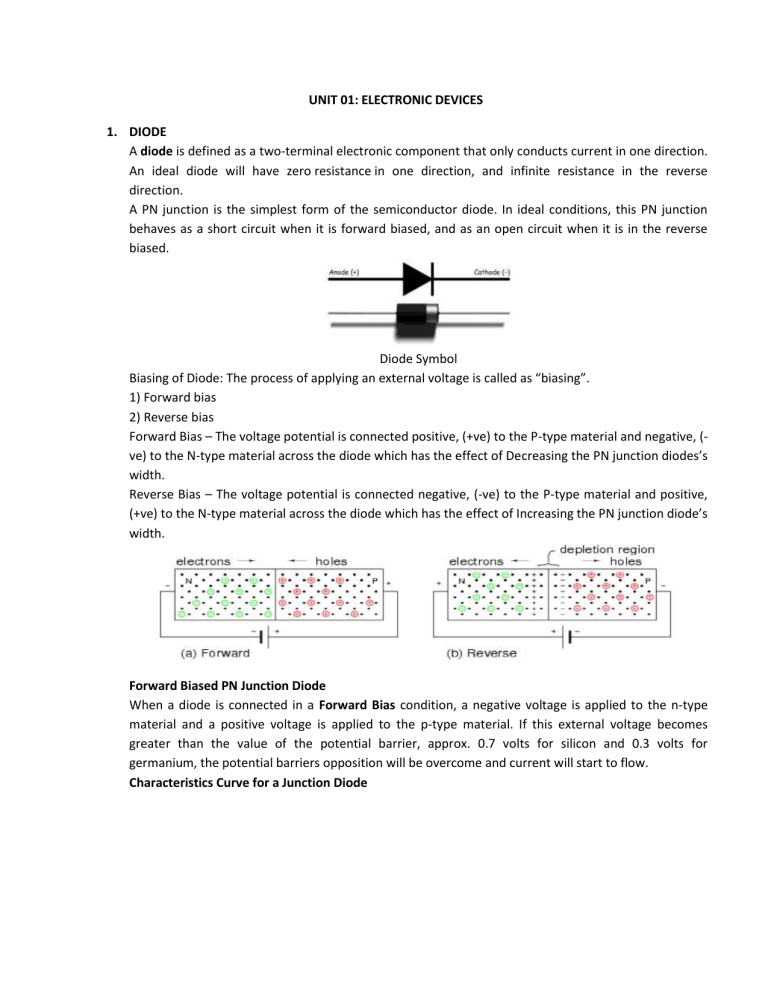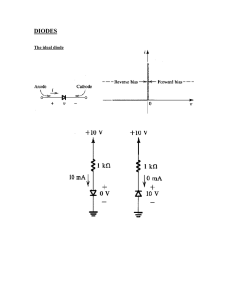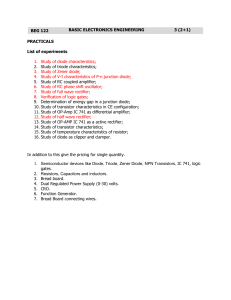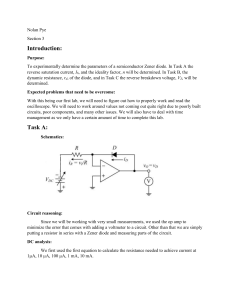
UNIT 01: ELECTRONIC DEVICES 1. DIODE A diode is defined as a two-terminal electronic component that only conducts current in one direction. An ideal diode will have zero resistance in one direction, and infinite resistance in the reverse direction. A PN junction is the simplest form of the semiconductor diode. In ideal conditions, this PN junction behaves as a short circuit when it is forward biased, and as an open circuit when it is in the reverse biased. Diode Symbol Biasing of Diode: The process of applying an external voltage is called as “biasing”. 1) Forward bias 2) Reverse bias Forward Bias – The voltage potential is connected positive, (+ve) to the P-type material and negative, (ve) to the N-type material across the diode which has the effect of Decreasing the PN junction diodes’s width. Reverse Bias – The voltage potential is connected negative, (-ve) to the P-type material and positive, (+ve) to the N-type material across the diode which has the effect of Increasing the PN junction diode’s width. Forward Biased PN Junction Diode When a diode is connected in a Forward Bias condition, a negative voltage is applied to the n-type material and a positive voltage is applied to the p-type material. If this external voltage becomes greater than the value of the potential barrier, approx. 0.7 volts for silicon and 0.3 volts for germanium, the potential barriers opposition will be overcome and current will start to flow. Characteristics Curve for a Junction Diode The application of a forward biasing voltage on the junction diode results: the depletion layer becoming very thin and narrow which represents a low impedance path through the junction thereby allowing high currents to flow. The point at which this sudden increase in current takes place is represented on the static I-V characteristics curve above as the “knee” point. Reduction in the Depletion Layer due to Forward Bias Reverse Biased PN Junction Diode When a diode is connected in a Reverse Bias condition, a positive voltage is applied to the N-type material and a negative voltage is applied to the P-type material. The positive voltage applied to the Ntype material attracts electrons towards the positive electrode and away from the junction, while the holes in the P-type end are also attracted away from the junction towards the negative electrode. Thus the depletion layer grows wider due to a lack of electrons and holes and presents a high impedance path, almost an insulator. The result is that a high potential barrier is created thus preventing current from flowing through the semiconductor material. a high resistance value to the PN junction and practically zero current flows through the junction diode with an increase in bias voltage. However, a very small leakage current does flow through the junction which can be measured in microamperes, ( μA ). Increase in the Depletion Layer due to Reverse Bias Reverse Characteristics Curve for a Junction Diode 2. Diode Equivalence Circuits: An equivalent circuit is a combination of elements properly chosen to best represent the actual terminal characteristics of a device, system, or such in a particular operating pregion. In other words, once the equivalent circuit is defined, the device symbol can be removed from a schematic and the equivalent circuit inserted in its place without severely affecting the actual behavior of the system. The result is often a network that can be solved using traditional circuit analysis techniques LOAD-LINE ANALYSIS: The applied load will normally have an important impact on the point or region of operation of a device. If the analysis is performed in a graphical manner, a line can be drawn on the characteristics of the device that represents the applied load. The intersection of the load line with the characteristics will determine the point of operation of the system. Such an analysis is, for obvious reasons, called load-line analysis. Applying Kirchhoff‟s voltage law to the series circuit of Fig. 2.1a will result in E-VD-VR = 0 E = VD + ID R Or …………..eq (1.1) If we set VD =0 V in Eq. (2.1) and solve for ID, we have the magnitude of ID on the vertical axis. Therefore, with VD =0 V, Eq. (2.1) becomes: 3. ZENER DIODES Zener diode is basically like an ordinary PN junction diode but normally operated in reverse biased condition. But ordinary PN junction diode connected in reverse biased condition is not used as Zener diode practically. A Zener diode is a specially designed, highly doped PN junction diode. Working Principle of zener diode A Zener diode operates just like a normal diode when it is forward-biased. However, when connected in reverse biased mode, a small leakage current flows through the diode. As the reverse voltage increases to the predetermined breakdown voltage (Vz), current starts flowing through the diode. The current increases to a maximum, which is determined by the series resistor, after which it stabilizes and remains constant over a wide range of applied voltage. There are two types of breakdowns for a Zener Diode: Avalanche Breakdown Zener Breakdown Avalanche Breakdown in Zener Diode Avalanche breakdown occurs both in normal diode and Zener Diode at high reverse voltage. When a high value of reverse voltage is applied to the PN junction, the free electrons gain sufficient energy and accelerate at high velocities. These free electrons moving at high velocity collides other atoms and knocks off more electrons. Due to this continuous collision, a large number of free electrons are generated as a result of electric current in the diode rapidly increases. This sudden increase in electric current may permanently destroy the normal diode, however, a Zener diode is designed to operate under avalanche breakdown and can sustain the sudden spike of current. Avalanche breakdown occurs in Zener diodes with Zener voltage (Vz) greater than 6V. Zener Breakdown in Zener Diode When the applied reverse bias voltage reaches closer to the Zener voltage, the electric field in the depletion region gets strong enough to pull electrons from their valence band. The valence electrons that gain sufficient energy from the strong electric field of the depletion region break free from the parent atom. At the Zener breakdown region, a small increase in the voltage results in the rapid increase of the electric current. Avalanche Breakdown vs Zener Breakdown The Zener effect is dominant in voltages up to 5.6 volts and the avalanche effect takes over above that. They are both similar effects, the difference being that the Zener effect is a quantum phenomenon and the avalanche effect is the movement of electrons in the valence band like in any electric current. Avalanche effect also allows a larger current through the diode than what a Zener breakdown would allow. Zener diode symbol Zener v-i characteristic The vi characteristic of the Zener to voltage reference diode is the key to its operation. In the forward direction, the diode performs like any other, but it is in the reverse direction where its specific performance parameters can be utilised. 4. Half-Wave Rectifier: Half-wave rectification: is the process of removing one half of the input signal to establish a dc level. The cct of the fig(3) called a half wave rectifiers will generates a waveform Vo that will have an average value of particular use in the ac– to–dc conversion process. Fig(3) half wave Rectifier During the interval (t=0 to T/2) the polarity of the input voltage Vi is shown in fig(4). Fig(4)conducting region(0 to T/2) The result that for period 0 to T/2, Vo=Vi. For period T/2 to T, the polarity of the input voltage Vi is shown in fig(5) and the ideal diode produces in off state, Vo=0V. Fig(5) Non conducting region (T/2 to T) An average value determined by average value determined by average dc value = 0.318Vm FIG(3.5) Half-Waves rectified signal 5. Full-Wave Rectification The dc level obtained from a sinusoidal input by half wave rectifier can be improved using a process called Full-Wave Rectification. There are two types- Bridge and CentreTap rectifier. Bridge Rectifier Four diodes in a bridge configuration can be used as Full Wave Rectifier as shown in fig (6). Fig (6.1) full –wave bridge rectifier T/2) fig (6.2) network for period (0 to For the positive region of the input the conducting diodes are D2 & D3 while D1& D4 are in the off state as shown in fig (6.3). Fig (6.3) For the negative region of the input the conducting diodes are D1 & D4 while D2 & D3 are in the off state as shown in fig (6.4) Fig(6. 4) The dc level for Full wave rectifier is twice that obtained for a half wave system i.e. average(d.c) level= 0.636Vm Over one full cycle the input and output voltage is shown in fig (4.5) Fig(4.5) Centre-Tap Rectifier A second popular full wave rectifier used only two diodes but requiring a centre tapped (CT) transformer to establish the input signal across each section of the secondary of the transformer as shown in fig (6.6). Fig(6.6) During the positive portion of Vi applied to the transformer, the diode D1 is short circuit and the diode D2 is open circuit. Fig(6.7) During the negative portion of Vi applied to the transformer, the diode D1 is open circuit and the diode D2 is short circuit as shown in fig (6.8). Fig(6.8) Fig(4.9)





